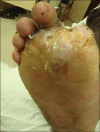Role of negative pressure wound therapy in healing of diabetic foot ulcers
- PMID: 22022649
- PMCID: PMC3192517
- DOI: 10.4103/2006-8808.78466
Role of negative pressure wound therapy in healing of diabetic foot ulcers
Abstract
Introduction: Foot disorders such as ulceration, infection and gangrene are the most common, complex and costly sequelae of diabetes mellitus.[1-3] Even for the most superficial wounds, treatment is often difficult with poor healing responses and high rates of complications. The purpose of this study is to compare the rate of ulcer healing with the negative pressure dressing technique to conventional moist dressings in the treatment of diabetic foot ulcers.
Materials and methods: The study was conducted on 30 patients, which were divided into two groups. One group received negative pressure dressing while other group received conventional saline moistened gauze dressing. Results were compared for rate of wound healing.
Results: There was a statistically significant difference in the rate of appearance of granulation tissue between the two groups; with granulation tissue appearing earlier in the study group. The study group promised a better outcome (80% complete responders) as compared to the control group (60% complete responders).
Conclusions: Negative pressure wound therapy has a definitive role in healing of diabetic foot ulcers.
Keywords: Healing; negative pressure dressing; ulcer.
Conflict of interest statement
Figures
References
-
- Ahmed AM. History of diabetes mellitus. Saudi Med J. 2002;23:373–8. - PubMed
-
- Marchal de Calvi A. Des rapports de la gangrène et de la glycosurie. Gazette des Hôpitaux Civils et Militaires. 1852;25:178.
-
- Hodgkin T. On diabetes. Assoc Med J. 1854;2:916–8.
-
- Singh N, Armstrong DG, Lipsky BA. Preventing Foot ulcers in patients with Diabetes. JAMA. 2005;293:217–28. - PubMed
-
- Boulton AJ, Vileikyte L. The diabetic foot: The scope of problem. J Fam Pract. 2000;49:S3–8. - PubMed
LinkOut - more resources
Full Text Sources





